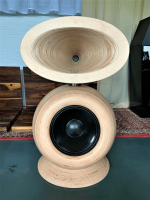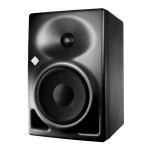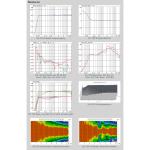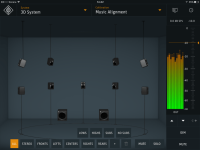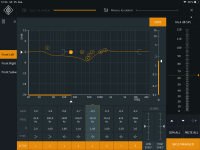Follow-up:
Your findings make perfect sense > I've stated previously that a true point source from 200Hz is hard to beat, even if the source isn't perfect due to breakup, or what have you.
The only thing that could spoil the experience is a 'mismatch' between your horn and the source below.
One could theorize endlessly about all known/mentioned factors, but imho (experience) the most important factor is matching the 'acoustic properties' of the sources. This consists of numerous factors, but to give a simple example (not so simple, or impractical to realize):
If you were to sandwich your mid/high horns between 2 frontloaded (mid) bass horns, you'll probably achieve the ultimate synergy and homogeneity - if done properly. Anything that deviates from this is a (greater) compromise.
Why would Florian Schneider (RIP) have used this setup for decades?

Your findings make perfect sense > I've stated previously that a true point source from 200Hz is hard to beat, even if the source isn't perfect due to breakup, or what have you.
The only thing that could spoil the experience is a 'mismatch' between your horn and the source below.
One could theorize endlessly about all known/mentioned factors, but imho (experience) the most important factor is matching the 'acoustic properties' of the sources. This consists of numerous factors, but to give a simple example (not so simple, or impractical to realize):
If you were to sandwich your mid/high horns between 2 frontloaded (mid) bass horns, you'll probably achieve the ultimate synergy and homogeneity - if done properly. Anything that deviates from this is a (greater) compromise.
Why would Florian Schneider (RIP) have used this setup for decades?
No doubt (in my mind) why the pioneers chose co/tri-ax woofer drivers and/or short (truncated) mid bass horns to blend woofers to mids/HF compression horns.Your findings make perfect sense > I've stated previously that a true point source from 200Hz is hard to beat, even if the source isn't perfect due to breakup, or what have you.
The only thing that could spoil the experience is a 'mismatch' between your horn and the source below.
Hi krivium. Yep, we've both mentioned the difference in studio near-field and acoustic near-field more than once.
Sure.
I don't think the studio near field definition and its associated critical distance, where direct-field equals reflected field,
has any bearing at all on the acoustic definition.
Well, from the contact i had with pro acousticians they always specify a kind of limit to the size of loudspeakers in relation too room.
I've been thinking it was related to some kind of 'maximum power' a room could withstand, which i've been told was a myth by Earl.
From there i wondered why a limit in size?
I do think now this is linked to the acoustic definition: if critical distance and acoustical definition of far field match it's for the better.
Yep, I think that's how most folks see it.
I don't anymore due to articles like the synaudcon mentioned (do check out how the article shows it can be harder / take more distance, to get into the acoustic far field for VHF than for low freg).
And I also measure freq response ripple with multiple drivers' polars, on my syns that are within 1/4WL summation. Like four closely spaced mid drivers.
I missed that article, will read it.
So i really believe it's simple triangulation of multiple source in the end, to listening/measuring location. And how that distance triangulation falls on the phase wheel, given frequency of interest.
No such thing as summed together never to be apart...kinda like marriage haha
It would match how i see Dunlavy approach.
Yep, but isn't that Fig3 is addressing beamwidth, without showing the freq response ripple associated with the beamwidth?
Could you point to a measurement where we can see this ripple?
120hz and below. I'd say its harder to spot 10khz from my 1" dome tweeter I have downstairs
Room modes hide location, but what if there is no mode there?
Outdoor? I already said i've heard and located 80hz outdoor. Was it from harmonics? Superpowers i doubt but who knows. Anyway i heard it.
For high freq there is modes. But there is so many we don't hear them as specular ones ( as we does in low end).
Two way with a dome tweeter which dispersion do they have? Do you have diffraction source nearbyw? Have you noticed Tmuikku and I were talking fullrange? 😉I play 10-12khz on my small two ways it sounds like its coming from everywhere lol!
Upstairs in front of the big one channel system, all I have to do is point my ear at the sub woofer and i can tell the spl drop as I move it away from that axis
I'm sure moving the thing outside won't be an easy task but i would try to be sure it is not room related.
Last edited:
I bet its those people who are using driver LF efficiency to design a low end response and cutoff... the same people who weren't wise to room eq and the benefits of a larger driver. The same people who claim they are "filterless" yet knew not that a crossover is just a bunch of filters.I've been thinking it was related to some kind of 'maximum power' a room could withstand, which i've been told was a myth by Earl.
Any chance you could link your papers so I could take a look? TIABeaming inherent to a 2" throat starts above ~7 kHz, the driver has little to no effect on directivity below that, so any beaming/narrowing around 4-5k must be the horn, typically a mouth diffraction. If you connect a truncated OS to a circular arc (as I gathered this is what you've done), this is exactly the kind of curvature discontinuity that causes this. This can be eliminated by making the whole profile a single smooth curve, as shown in my papers.
A fetish?Why would Florian Schneider (RIP) have used this setup for decades?
Yep, will do. I'll make a set of polars where the entire bandwidth of the multiple mid drivers being used is within 1/4WL frequency.Could you point to a measurement where we can see this ripple?
I'll do it on the syn11 box outdoors, far-field.
Got a new test rig to try out...multiple mics vertically, so in conjunction with a spinorama for horizontal rotation, I can get all kinds of off-ax meas.
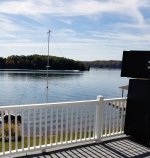
I'm sorry for resurrecting the last year's comment, but I tried what was suggested then and have some data to show."The horn does play a big role. With that said. Even on the giant 2360A the Axi2050 still runs out of gas due to diaphragm displacement limitations near 300Hz. This isn't really seen until absurd output levels with more than 10 volts applied = REAL LOUD, so technically you could get away with a 300Hz Xo on that horn in most cases."
https://data-bass.ipbhost.com/topic...pression-driver/?do=findComment&comment=24944
Here is a distortion plot of HF1440 with first order high-pass filter @3000Hz, which results in acoustic 4th order high-pass @450Hz in a HF950 horn. I took the measurement at about 90dB. Despite the very low crossover point, the CD has a lower 3rd harmonic than a 12'' Beyma woofer it's being crossed to.
I suppose that a driver without a back cover can play even cleaner than that. Unfortunately, HF1440 magnet is built into the rear-cover:
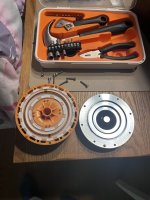
Toolbox interior matching the driver's😉
Nice performance!
Didn't you happen to compare the RCF ND950?
A few days ago, I saw another measurement plot of the ND950 showing exceptionally low distortion values.
Nice performance!
Didn't you happen to compare the RCF ND950?
A few days ago, I saw another measurement plot of the ND950 showing exceptionally low distortion values.
Last edited:
28 and 29 are the true performers of this study, not sure why they state otherwise.... One of the other configurations that they claim is one of the best, they didn't test in real life...sorta annoying. For example, why didn't they test the configuration below, in real life.... I guess its not that trivial since the mathlab results were somewhat precise. 4 subs it is....
I've been studying and it seems that Cardioid isn't as effective with the proximity of borders, that includes the floor, which I forgot to include when simulating in the past. I always planned on corner loading, so it seems that aiming for 4 subs woofers will make more sense.
Last edited:
Didn't you happen to compare the RCF ND950?
A few days ago, I saw another measurement plot of the ND950 showing exceptionally low distortion values.
Yes, I owned both at the same time. Here is a comparison of the frequency response in the same HF950 horn:
https://www.diyaudio.com/community/...r-from-faital-pro.336505/page-10#post-6620372
I found this distortion chart in my archive. I don't remember the measurement level though. I also suppose that I made measurement of ND950 using expensive Neumann mics and good Focusrite interface I happened to own a couple of years ago. Measurements of HF1440 above were made using inexpensive Oktava mics and cheap Presonus Audiobox interface.
When I happened to have these expensive Neumann mics, I noticed that they show much lower distortion levels compared to measurements I did with Umik-1 mic. It seems that Umik's own distortion level is higher than those of the compression driver. We cannot directly compare ND950 measurements to HF1440 measurements above.
My friend still own ND940. It's also suitable for the low crossover. Actually, it was his idea to cross the compress driver using an electrical first-order high-pass filter.
Your chart of HF1460 mounted in KH53 horn looks very promising too. Also, according to images, the HF1460 allows one to unscrew the rear chamber, right? I suppose that may help with the lower crossover point too. There is something happening with HF1440 around 1Khz. May it be a resonance of the rear chamber?
Wanted only to bring to memory that it is without problems possible to cover the complete audio spectrum with one driver and with good loudness capabilities.
You could even put the 15 inch fullrange driver "Fane Sovereign 15-300 TC" into to a big backloaded horn and have a convincing sound for PA.
https://www.diyaudio.com/community/...w-distortion-with-a-2-way.334757/post-6711184

You could even put the 15 inch fullrange driver "Fane Sovereign 15-300 TC" into to a big backloaded horn and have a convincing sound for PA.
https://www.diyaudio.com/community/...w-distortion-with-a-2-way.334757/post-6711184
Look at that phase response! With no eq.View attachment 1152490
Does anyone else find this phase questionable? At 250 and 150hz there are obvious nulls, yet you see nothing in the phase.
- Home
- Loudspeakers
- Multi-Way
- Is it possible to cover the whole spectrum, high SPL, low distortion with a 2-way?
